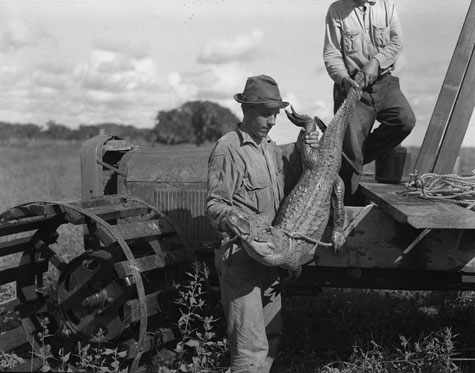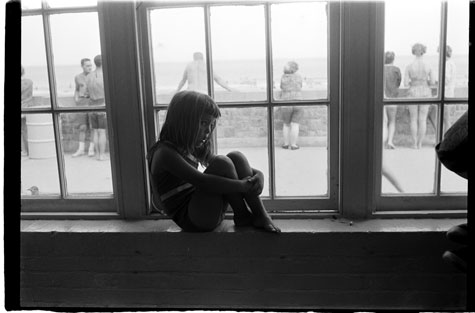
GATOR GRAPPLING Link's Catch of the Day.
|
It wasn't until the 1970s that O. Winston Link got noticed by the art world. The New Yorker had been a professional photographer since the 1930s, shooting publicity shots for an advertising firm before World War II and doing freelance commercial photography afterward. It was a decent living, but it was anonymous work.At Bert Gallery (540 South Water Street, Providence), you can see the photos that finally grabbed people's attention — as well as work by Carmel Vitullo of Warwick, who is best known for her mid-century Providence photos. "Documenting a Moment, a Place, an Era" (through August 28) features a handful of Link's astonishing 1950s nighttime shots of the last steam trains on the Norfolk and Western Railway across Virginia, West Virginia, and North Carolina. He spent hours arranging people and (usually moving) trains in each shot, and then elaborately lighting the scene. He composed with his flash bulbs, illuminating just the elements he wished to include and leaving the rest in darkness as he fashioned seductive nighttime dramas. Shot with 4x5" cameras, they are the antithesis of the candid, available light, street photography that dominated the upper reaches of photography at the time (and which Vitullo's work is part of).

One 1956 shot shows cars lined up at a drive-in cinema as we look over the shoulders of a couple cuddling in a convertible in the foreground. The movie features a jet flying by. Along a banking to the right, a freight train rushes past. It's an awesomely orchestrated, and too deliciously good to be exactly true, ode to American transportation.
Most of Link's work here was shot in Louisiana between 1937 and '41, when he was fresh out of college and his advertising firm was hired to improve the state's reputation. The shots feature a girl sitting atop a beehive eating a honeycomb, boys sitting on a diving board along the water as a storm blows up on the horizon, and sweaty oil men crammed into bunks. Some photos stand out for their artistry. A photo of a party for farmers at the governor's mansion sparkles because of Link's point of view — looking down from above the crowd — and the rhythm of hats through the scene. Note how another shot of two women in an outdoor New Orleans restaurant is carefully framed by the garden's vines. Note Link's attention to the soft reflected light on the woman's face, and the light coming through the palm fronds. But Link's elaborate, passionate directions aren't much in evidence. Maybe he hadn't developed them yet, maybe he was working too quickly, maybe Louisiana wasn't his thing (though he did find his first wife there). They're interesting as windows into another time and place — like his Louisiana shots of men hunting alligators.
To some eyes, Carmel Vitullo's big moment came in the '50s when New York's Museum of Modern Art bought a few of her photos and included her shot of European refugees waiting at New York's Grand Central Station in its landmark 1955 post-war exhibition "The Family of Man." The wary, tired men, women, and children sit on benches, with their suitcases lined up before them, under a grid of shadows cast by the building's skylights. You can see why it was selected for the show — it's a dramatic moment dramatically composed.

A WORLD OF HER OWN Vitullo's Narragansett Pier.
|
Vitullo grew up in the Italian community of Providence's Federal Hill, and most of her photos here depict that neighborhood in the '50s — women behind the counter of a pizza joint, kids playing on the sidewalk, men among the produce bins of a street market, girls munching peanuts as three old ladies (their grandmothers?) chat behind them, men in overcoats conversing on a street corner. They don't have the drama of that refugee photo, but they hold you because of their subjects (this town) and their age.Still, a closely-framed photo of a man waiting in the front seat of a car, while a woman sleeps across the back seat, could be an outtake from Robert Frank's "The Americans." And see how much drama Vitullo draws from the light in a photo of a girl curled up in a windowsill at Narragansett Pier as people stand outside in the sun. The girl sits in the shadows, tiny and isolated, in a world of her own.